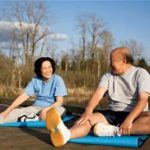
By Lois Manzella-Marchitto
What happens to the body during a warmup
The main purpose of a warm-up is to prepare the body for exercise, increase circulation, primes your nerve to muscle pathways and increases heart rate. Warming up prepares the body to use the muscles and helps to prevent injuries such as muscle strains. One of the ways warming up works is to raise the temperature of the body. It also prepares the mind for the various ranges of motion that you might perform in the exercise ahead.
The best way to warm up is to use each muscle group that you’ll be using in exercise. In a warm-up, you use partial motions. You don’t need to do cardiovascular movements to warm up, but you can.
Types of warm-ups
A warm-up in a is a partial range of motion. A shorter range of motion and alternating in each movement one for a second or two to get everything woken up and ready to roll. You can do a warm-up of one set of a variety of exercises you’ll be doing later, to get your body ready for them. We suggest marching in place, gentle twisting, arm circles, hip circles, reaching over head, alternating knee raises, side lunges, reverse lunges with a shorter range of motion.
Things to avoid when warming up
There are good ways to warm up, and there are also things to avoid. Here are a few warm-up things to never do:
-
Static stretching individual muscles before working out. This could be harmful to most people. Avoid static stretching unless you are a gymnast or professional dancer. The reason for this is that you should not be extending the muscle past where you’re going to be training it in. It could cause more harm than good.
-
“Rolling out” with foam rollers in place of a dynamic warm up. There are certain parts of your body that you should never roll out. For example the IT (iliotibial band) is a piece of connective tissue and cannot be released using manual techniques like foam rolling. Rolling out can be done in some instances but learning correct technique, knowing where the pain is originated, going slowing, spending appropriately amounts of time and having good posture are needed. Often, because of the variables to foam roll correctly it causes more harm than good and exercisers end up in physical therapy.
-
Warming up in a single plane of motion. If you’re only warming up by moving front to back, your muscles will not be prepared for sideways or diagonal. These motions may happen during exercising and not warming up for them makes injuries more likely.
Cooling down after a workout
Now that we’ve covered why warming up is important before exercising, we’ll talk about why cooling down is essential too.
Cooling down is just as important. Like warming up, you’re bringing your body gradually back to your normal pre-exercise heart rate, temperature, and blood pressure.
For 5-10 minutes after exercising, cool down to lower your heart rate, bring it back down, and stretch. Hold a stretch between 10 and 20 seconds. Feeling the stretch without overdoing it. Don’t go to the point where you feel pain. It should feel good, and you should go slowly. As you’re inhaling, get ready to stretch. As you’re exhaling, do the stretch.
Flexibility work should be done at the end of your workout when the muscles are elastic and warm. Stretching while your muscles are warm allow them to safely extend through their range of motion and back to resting.
Working out comfortably is working out safely
During warm-ups, cool-downs, and exercising, focusing on relative comfort can help keep your body safe, healthy, and ready for working out next time. Keeping in mind how your workout feels can help you make safe choices that avoid injuries.
Lois is the Owner and Managing Officer of Fitness Knocking- www.fitnessknocking.com
